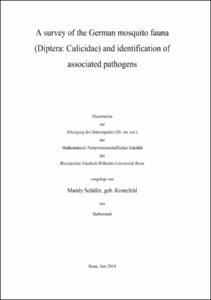A survey of the German mosquito fauna (Diptera: Culicidae) and identification of associated pathogens

A survey of the German mosquito fauna (Diptera: Culicidae) and identification of associated pathogens

| dc.contributor.advisor | Kampen, Helge | |
| dc.contributor.author | Schäfer, Mandy | |
| dc.date.accessioned | 2020-04-20T20:14:24Z | |
| dc.date.available | 2020-04-20T20:14:24Z | |
| dc.date.issued | 13.02.2015 | |
| dc.identifier.uri | https://hdl.handle.net/20.500.11811/6418 | |
| dc.description.abstract | As a consequence of fundamental environmental, economic and demographic changes worldwide, vector-borne diseases are becoming of increasing public and animal health significance in Europe, owing to their geographical expansion and the growing number of cases. Meeting these developments, a study on the occurrence and distribution of mosquitoes of the Maculipennis Group in Germany was undertaken and a method for their reliable differeniation was developed within the framework of a nationwide mosquito monitoring programme from 2011 to 2013. A total of 1,105 Anopheles specimens of the Maculipennis Group were collected at 185 localities across 13 federal states throughout Germany. Following a comparative sequence analysis of the internal transcribed spacer 2 (ITS2) ribosomal DNA (rDNA), Anopheles daciae was demonstrated as the 49th mosquito species in Germany. Due to the high genetic similarity to Anopheles messeae, An. daciae has previously been overlooked in Germany using the most common species-specific multiplex PCR assay. The discovery of An. daciae prompted the adjustment of the species-specific multiplex PCR assay to distinguish the presently known members of the European Maculipennis Group including An. daciae. Taking into account the described sequence polymorphisms, a primer species-specific for An. daciae was designed, allowing the differentiation of the four Maculipennis Group species occurring in Germany plus Anopheles sacharovi, Anopheles melanoon and Anopheles labranchiae, which are mainly present in southern Europe. In addition to the formerly known species Anopheles atroparvus, Anopheles maculipennis and An. messeae, the newly described cryptic species An. daciae was identified in seven federal states of Germany, indicating a nationwide distribution. The sympatric occurrence together with An. messeae and An. maculipennis at some sampling sites also indicates that An. daciae has similar ecological requirements, but corresponding investigations have yet to be carried out. The second part of the thesis focusses on the molecular examination of mosquitoes for viruses of the family Bunyaviridae, Flaviviridae and Togaviridae and for filarial nematodes of human and veterinary importance. Approximately 17,000 identified female mosquitoes were pooled by species, collection site and date with up to 25 specimens per pool. This was followed by a combined isolation of DNA and RNA, allowing the simultaneous screening for various pathogens. For screening the mosquito pools for filarial nematodes of the superfamily Filarioidea, conserved regions were identified in mitochondrial DNA sequences of parasitic nematode species and primers for a filarioid-specific real-time PCR assay were designed. For screening the mosquitoes for viruses, published qRT-PCRs and newly developed in-house assays were applied. Except for two unknown filarioid species in Culex pipiens/torrentium, Setaria tundra, a common filarial nematode of cervids, was detected in the flood water mosquito Aedes vexans collected in Baden-Wurttemberg, Lower Saxony and Bavaria in three consecutive years. Of particular importance are the findings of two zoonotic filarial nematode species, Dirofilaria immitis and Dirofilaria repens, in Cx. pipiens/torrentium and An. daciae from Baden-Wurttemberg and Brandenburg in 2012. Zoonotic mosquito-borne viruses of the family Bunyaviridae, Flaviviridae and Togaviridae could not be demonstrated in indigenous mosquitoes, suggesting a minor importance at present. However, flaviviral sequences found in the banded house mosquito Culiseta annulata revealed a close relationship with insect-specific flaviviruses from Ae. vexans in Spain. Similar findings of viruses with no recognized pathogenic role in humans are increasingly reported worldwide from studies targeted at mosquito-borne flaviviruses. The results of this study clearly indicate that mosquito-borne diseases should no longer be neglected by physicians, veterinarians, public health personnel and policy makers. After all, the surveillance of mosquitoes and associated pathogens enable the early detection of changes in the mosquito fauna and the introduction of non-indigenous mosquito-borne pathogens. | en |
| dc.language.iso | eng | |
| dc.rights | In Copyright | |
| dc.rights.uri | http://rightsstatements.org/vocab/InC/1.0/ | |
| dc.subject | Anopheles daciae | |
| dc.subject | Maculipennis-Gruppe | |
| dc.subject | Dirofilaria | |
| dc.subject | Setaria | |
| dc.subject | Deutschland | |
| dc.subject | Culicidae | |
| dc.subject | Bunyaviridae | |
| dc.subject | Flaviviridae | |
| dc.subject | Togaviridae | |
| dc.subject | Maculipennis Group | |
| dc.subject | Germany | |
| dc.subject.ddc | 590 Tiere (Zoologie) | |
| dc.subject.ddc | 610 Medizin, Gesundheit | |
| dc.title | A survey of the German mosquito fauna (Diptera: Culicidae) and identification of associated pathogens | |
| dc.type | Dissertation oder Habilitation | |
| dc.publisher.name | Universitäts- und Landesbibliothek Bonn | |
| dc.publisher.location | Bonn | |
| dc.rights.accessRights | openAccess | |
| dc.identifier.urn | https://nbn-resolving.org/urn:nbn:de:hbz:5n-39133 | |
| ulbbn.pubtype | Erstveröffentlichung | |
| ulbbn.birthname | Kronefeld | |
| ulbbnediss.affiliation.name | Rheinische Friedrich-Wilhelms-Universität Bonn | |
| ulbbnediss.affiliation.location | Bonn | |
| ulbbnediss.thesis.level | Dissertation | |
| ulbbnediss.dissID | 3913 | |
| ulbbnediss.date.accepted | 21.01.2015 | |
| ulbbnediss.institute | Mathematisch-Naturwissenschaftliche Fakultät : Fachgruppe Biologie / Institut für Zoologie (IZ) | |
| ulbbnediss.fakultaet | Mathematisch-Naturwissenschaftliche Fakultät | |
| dc.contributor.coReferee | Misof, Bernhard |
Dateien zu dieser Ressource
Das Dokument erscheint in:
-
E-Dissertationen (4379)




